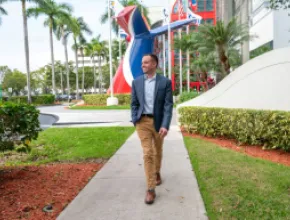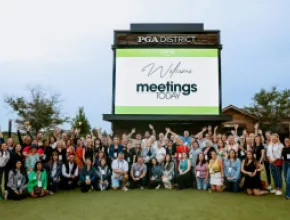Cooling heat islands is the first step in creating a better urban environment.
It should come as no surprise that Phoenix, which is literally named after a mythic bird that burst into flames, is the hottest metropolis in the U.S. While that ambient warmth attracts about 47 million visitors a year to the city, mainly during its delightful winter and shoulder seasons, it still means that summer is very, very hot.
That situation, however, is changing for two reasons.
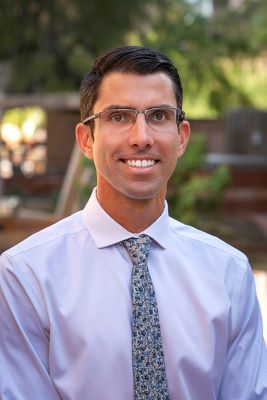
First, temperatures are rising everywhere—sometimes dramatically, like the heat dome that covered most of the northeast U.S. this past June, and sometimes insidiously, like the up-ticking temperatures associated with climate change. Thus, when everything is hot, doesn’t it make sense that cities used to coping with heat might have the advantage?
The second reason is that Phoenix has launched several eco-initiatives intended to bring temperatures down in places where “heat islands”—non-reflective surfaces—magnify the air temperatures. It’s a goal various city agencies have been striving for, and happily their efforts are having the desired effects.
In late 2021, Phoenix established the Heat Response & Mitigation Office, the first publicly funded effort in the U.S. It is headed up by Arizona State University (ASU) Associate Professor David Hondula, who has been with the university since 2013. Prior to his new role, Hondula led the Arizona Heat Resilience Working Group, co-organized and hosted the annual Arizona Extreme Heat Planning Workshop and was senior investigator for Arizona’s participation in the CDC Climate-Ready Cities and States Initiative.
“Research consistently identifies urban cores, neighborhoods with low tree canopy cover and places with extensive coverage of impervious surfaces to be the hottest parts of the Phoenix metropolitan area,” Hondula noted.
Why does this matter for prospective meeting groups in the Valley of the Sun? Despite the rising temperatures, Phoenix is a place where viable strategies for urban cooling are taking place, and visitors for meetings and conventions have a chance to experience it, participate in it and even take away lessons that can be applied at home.
[Related: 5 Tips for Preventing Heat-Related Illnesses at Outdoor Events]
Cooling Initiatives for Rooftops, Pavements and Corridors
Three “cooling” initiatives for rooftops, pavements and corridors are currently being used to prevent heat-trapping. At this time, over 70,000 square feet of city-owned properties have been painted with reflective, cool roof coatings, which have “resulted in a 17% reduction in energy consumption for those participating buildings,” according to a 2021 memorandum by The Urban Heat Island and Tree and Shade Subcommittee.
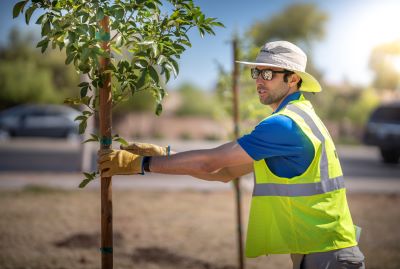
With rooftops and pavements, a water-based reflective seal can be apprised to reduce the heat island effect of asphalt and dark roofs. According to evaluation results posted on its website, “Cool pavement reduces surface temperatures by up to 12° F,” Hondula said. In July 2023, The Washington Post took an infrared camera through the streets of Phoenix, measuring the differences in heat between pavement treated with the cooling seat and naked asphalt.
The program is expected to complete 4,000 miles of road but has so far treated 100 miles. It was also paused this summer while the perceived versus actual benefits are measured.
Testifying to the U.S. Congress in 2023, Hondula acknowledged that “the surface temperature of streets coated with cool pavement was lower at all times of the day compared to traditional asphalt…and sub-surface temperatures measured in the asphalt below the cool pavement coating averaged 4.8° F lower than sub-surface temperatures in untreated streets…but the thermal comfort of a pedestrian walking on the sidewalk adjacent to a street coated with cool pavement was not significantly influenced by the treatment.”
He agreed that “continued evaluation of cool pavement technologies is needed to fully understand their long-term performance concerning infrastructure protection and urban heat mitigation.”
[Related: A Growing Technology Sector in Phoenix Is Increasing the City’s Intellectual Capital]
Plans to Create More Shade
Another long-term goal is to plant native trees along sidewalks to provide shade and help pedestrians travel more comfortably with less water expenditure. According to the Bulletin of the American Meteorological Society, which conducted experiments in nearby Tempe, tree shade can reduce the heat load on the human body by at least 30° F.
“Species selection and appropriate watering plans are integral components of tree planting initiatives in the city,” Hondula said. “In its newly released Shade Phoenix Plan, the city is prioritizing unshaded locations with high pedestrian traffic for trees and built shade investments.”
In this program, the city plans to plant up to 1,800 trees along nine miles with heavy pedestrian traffic.
Groups in town for meetings and conventions can get involved in these efforts.
“The City of Phoenix has supported certain large events at and near the convention center this summer with heat relief outreach teams and heat relief stations,” Hondula said. “It periodically engages with local and visiting groups such as Downtown Phoenix, Inc., and Visit Phoenix, who wish to engage in CSR activities, such as planting trees.”
[Related: Taking Off: Luxury Property Enhancements and More Elevate Events in Scottsdale, Arizona]
For Groups That Want to Make an Impact
Of course, these are far from the only ways meeting groups make a positive environmental impact on Phoenix or, indeed, on any city. For groups aspiring to a “culture of conservation,” the Phoenix Convention Center (PCC) offers a CSR checklist with standard operating practices.
These include reducing carbon footprints by staying close to the designated meeting area and using public transportation to get around, as well as sustainable catering practices and restaurants that use local food sourcing; waste sorting during move-in and move-out; and food and exhibit materials donations to local charities—especially the repurposing of banners into tote bags.
The PCC also suggests coordinating with a sustainability coordinator to purchase renewable energy certificates during event days, ensuring events are run on renewable energy.
Meanwhile, planners who expect to bring meetings to the Valley of the Sun during the summer can access the Heat Office’s Weekly Heat Report to keep attendees informed about heat and safety tips.
[Related: How Phoenix Can Help Your Event Prioritize Wellness]
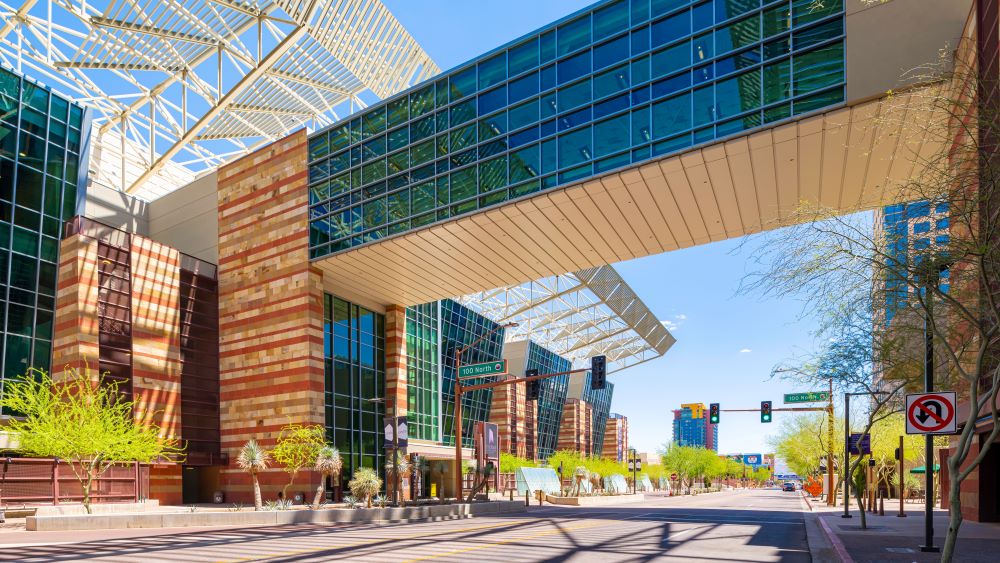
The Latest and Greatest Developments in Arizona
Glendale
While Glendale’s Mattel Adventure Park appears to be on track for opening this fall, its adjacent VAI Resort is slated to debut in phases during 2025. The 1,200-room property is expected to feature a 20,000-square-foot spa and wellness center, over 40,000 square feet of flexible ballrooms and meeting spaces and other amenities. The hotel is located near State Farm Stadium in Glendale’s heart.
Phoenix
Signs still point to the 2025 opening of the 259-room Fairmont Phoenix Downtown in the city’s historic Warehouse District, offering groups convening at the Phoenix Convention Center a new accommodations choice. The property will debut in a 25-story mixed-use structure that will also feature 151 residential condominiums ranging from one to three bedrooms, with amenities ranging from a restaurant, lobby bar, rooftop pool with a bar and cafe, spa and gym to retail and meeting spaces. The property will also be near the Chase Field and Footprint Center sports centers.
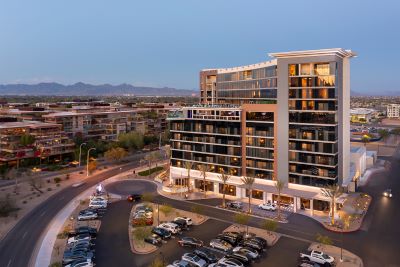
Scottsdale
The 265-room Caesars Republic Scottsdale opened in March 2024. It is the famous gaming brand’s first non-gaming hotel in the U.S. The luxury hotel features a 7,000-square-foot, column-free ballroom where 34-foot sliding glass doors open onto the adjacent lawn, which can host events for up to 600 people. Five breakout rooms can accommodate up to 200 when joined.
The Ritz-Carlton Paradise Valley–The Palmeraie is expected to open in late 2024/early 2025. Its 215-room inventory will feature casitas and bungalows. Amenities include a 16,000-square-foot spa, a 2,500-square-foot state-of-the-art health and fitness center and a 400-tree citrus orchard. The meeting space will comprise 20,000 square feet of indoor/outdoor space, including an amphitheater.
Connect





